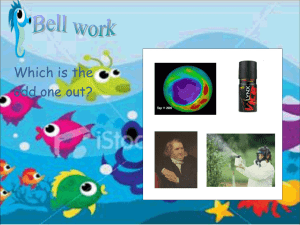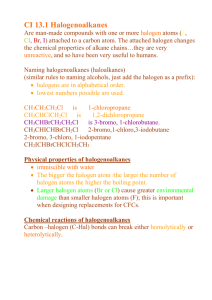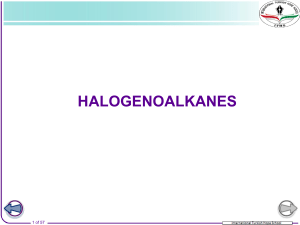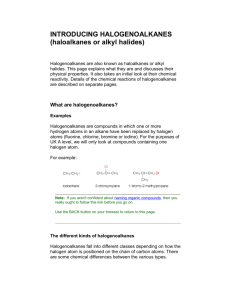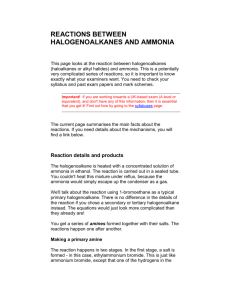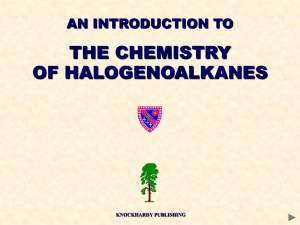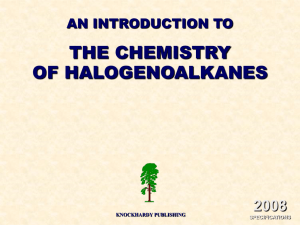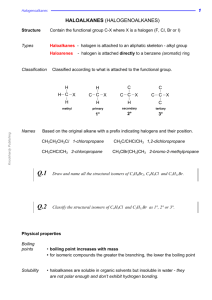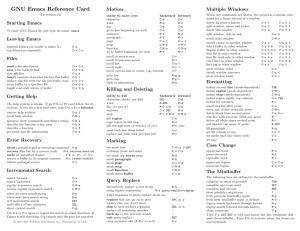File
advertisement
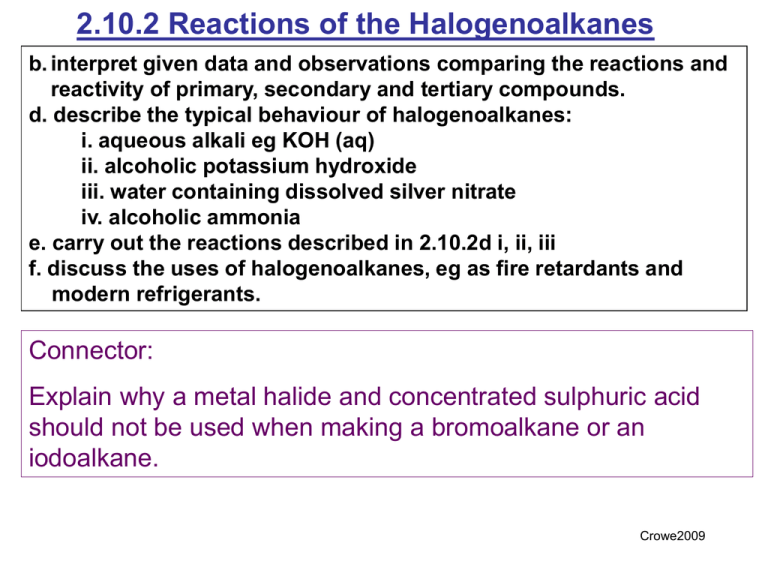
2.10.2 Reactions of the Halogenoalkanes b. interpret given data and observations comparing the reactions and reactivity of primary, secondary and tertiary compounds. d. describe the typical behaviour of halogenoalkanes: i. aqueous alkali eg KOH (aq) ii. alcoholic potassium hydroxide iii. water containing dissolved silver nitrate iv. alcoholic ammonia e. carry out the reactions described in 2.10.2d i, ii, iii f. discuss the uses of halogenoalkanes, eg as fire retardants and modern refrigerants. Connector: Explain why a metal halide and concentrated sulphuric acid should not be used when making a bromoalkane or an iodoalkane. Crowe2009 Practical 2.15 reactions of the halogenoalkanes Bond strengths Bond C-F C-Cl C-Br C-I Bond length (nm) 0.138 0.177 0.194 0.214 Bond enthalpy (kJmol-1) 467 346 290 228 • What is the link between bond length and bond strength? • In a substitution reaction the C-X bond is broken. Which type of halogenoalkane will be the most reactive? • Why are fluorocarbons very unreactive? Reactions of halogenoalkanes – Nucleophilic substitution .1 With aqueous potassium hydroxide solution H2O CH3CH2CH2Br + OHCH3CH2CH2OH + Br• What is a nucleophile? • The C-X bond is polar, which C-X bond will be the most polar? • Compare your answer above, to the order of reactivity of RX compounds. • Which is the most important factor in deciding the rate of reaction: the strength of the C-X bond, or the polarity of the bond? Reactions of halogenoalkanes – Nucleophilic substitution .2 With alcoholic ammonia CH3CH2CH2Br + NH3 CH3CH2CH2NH2 + HBr 1-aminopropane • How does ammonia act as a nucleophile? • Is 1-aminopropane a nucleophile? Explain your answer. • Suggest what could happen once an appreciable amount of 1-aminopropane has formed. In the presence of excess alcoholic ammonia* further reactions occur to produce a mixture of all possible products: CH3CH2CH2Br + CH3CH2CH2NH2 CH3CH2CH2Br + (CH3CH2CH2)2NH CH3CH2CH2Br + (CH3CH2CH2)3N (CH3CH2CH2)2NH + HBr di-(1-aminopropane) (CH3CH2CH2)3N + HBr tri-(1-aminopropane) (CH3CH2CH2)4N+Brtetrapropylammonium bromide * 1-bromopropane is heated with a concentrated solution of ammonia in ethanol, in a sealed tube to prevent the ammonia escaping. Reactions of halogenoalkanes Elimination reaction using alcoholic KOH HH l l H-C-C-H + OHl l H Br bromoethane H H ethanol l l H-C=C-H + H2O + Br ethene •Why is this called an elimination reaction? •How does this reaction differ from that which was used to make an alcohol? Identification of halogenoalkanes To a sample of an halogenoalkane add 1cm3 of ethanol followed by 1cm3 of aqueous silver nitrate. Stand the test tube in a beaker of hot water for a few minutes. ion present Observation Cl- White ppt. Br- Pale cream ppt. I- Yellow ppt Further tests: White precipitate of silver chloride soluble in dilute ammonia. Cream precipitate of silver bromide, only soluble in concentrated ammonia. Yellow precipitate of silver iodide insoluble in concentrated ammonia.

